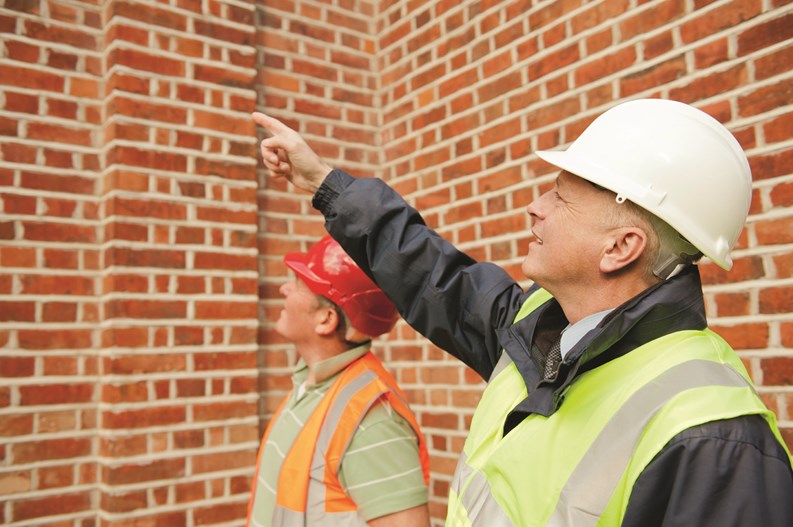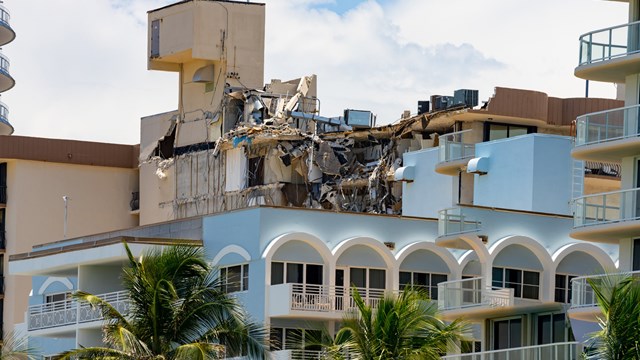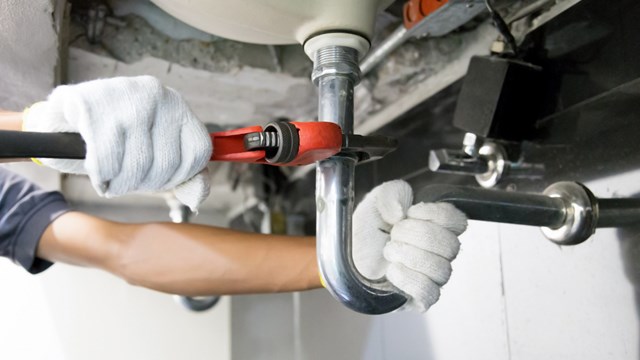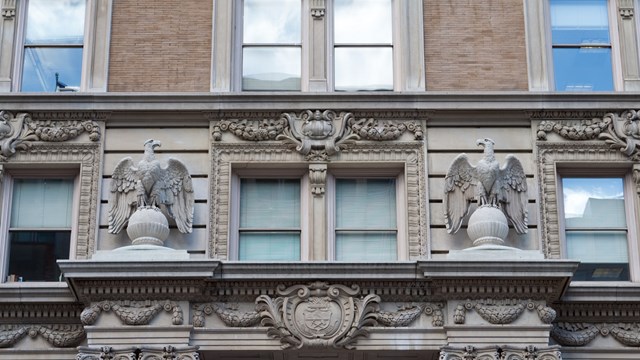Exteriors of buildings, including condo and HOA buildings, aren’t always smooth brick walls. There are all sorts of indentations and protrusions, from terraces to stonework to cornices. There are also items that are not part of the building, but are affixed to it, like scaffolds and window air conditioners. And if such items are poorly secured or loose, this could lead to disaster.
Every once in a while, New Yorkers will hear of a “high wind advisory,” usually in conjunction with a thunderstorm, hurricane, or nor’easter. And as strange as it may seem to people who equate tornadoes with places like Kansas and Oklahoma, Brooklyn and Queens saw two of them in recent years, one in 2010 and the other in 2012.
If something is loose on the exterior of your building, high winds make them vulnerable, whether you’re in the city itself or the suburbs. There are also other causes, such as construction accidents or material that comes loose after a number of years:
Consider these incidents:
In May, a two-year-old girl was left brain-dead and later died after bricks rained down on her and her grandmother. Terra cotta bricks fell from a window ledge of a seniors’ high-rise residential building on West End Avenue.
Also in May, a piece of mechanical equipment being lifted by a crane at a Manhattan office building broke free and fell 28 stories to the street below, injuring construction workers, pedestrians, and occupants of a passing car.
In September 2014, a not-too-stable window air conditioning unit plummeted from a sixth-floor window, hitting a pedestrian in the head and injuring her leg.
Across the river in West New York, New Jersey, in June 2014, four people were injured when bricks fell from the second-floor façade of a building. The mayor, who is also a doctor, ran from his nearby office and helped the victims.
“I actually saw an A/C unit fall,” said Wayne Bellet, president of Bellet Construction in Manhattan. “It’s very frightening—it’s like a hand grenade. The pieces went everywhere.”
What kind of material or device, either affixed to the building, installed on the building or part of the building, could become loose and create potentially deadly hazards?
Among the many items are:
• Construction debris left on the roof or elsewhere (plywood, bricks, paint cans, ladders, tools, etc.)
• Loose bricks.
• Protective canopies used during construction.
• Scaffolds for workers who are doing work on the exterior of a building.
• Loose stonework.
• Terra cotta (mainly on older buildings).
• Siding material.
• Signage.
• Furniture on terraces and roof decks.
• Window air conditioning units and fans.
• Corrugated metal.
• Antennas and satellite dishes.
• Awnings.
• Planters and potted trees.
• Fences and guard rails.
• Solar panels.
• Coping stones, which form the top of a roof parapet wall.
The urgency of some of the problems have changed over the years. “In the past,” says Bellet, “the worst offenders were antennas, both TV antennas and amateur radio (HAM) antennas. Then came the satellite dishes, which were worse, although we haven’t been seeing as many of them lately.”
It’s in the Code
Alexander Schnell, a spokesman for the New York City Department of Buildings (DOB), provides a brief rundown of the city’s regulations regarding exterior wall maintenance. He notes, “There is Local Law 11 of 1998 and the rule for the maintenance inspections, as well as the provision for the Administrative Section of the 2014 Construction Codes. It should be noted that while only buildings greater than six stories are subject to the Façade Inspection Safety Program (FISP, previously known as Local Law 11 inspections), all buildings must maintain their exterior walls in a safe and code-complaint manner at all times. A failure to do so may result in violations and additional enforcement by the department.”
In general, according to Article 302, Maintenance of Exterior Walls, says Schnell, inspections are done at staggered intervals set forth by the Department of Buildings (DOB). They must be done by a design professional on behalf of the building owner. A report must be submitted within 60 days of the inspection. Exterior walls including appurtenances, the term used for items affixed to the wall but not really part of it, can be classified as either safe, SWARMP (Safe With a Repair and Maintenance Program), or unsafe.
If a report uncovers unsafe conditions, according to the DOB, all such conditions must be corrected within 90 days. The design professional must submit a new report within two weeks of the time the repairs have been done. Building owners can get an extension of up to 90 days, but must do so by order of the building commissioner.
So far, we’ve just been talking about New York City. But contractors, engineers and management companies who work in large geographical areas must also remember that the codes are different in every municipality. There are similarities between all of them, but the code in New York City is different than the code in Mount Vernon. That’s why it’s best for a board or management to hire a local attorney who knows the local building regulations.
Inspections In-Depth
“As per FISP,” says David Merabyan, president of Engineering of Construction in Brooklyn, “inspection requirements include facades, balconies, fire escapes and guard rails. It is the responsibility of a qualified exterior wall inspector (QEWI), who is a New York State professional engineer, registered architect, or their assistant, performing the inspection under PE or RA supervision.
“Generally speaking,” he says, “all secured points have to maintain their original design capacity to withstand [external] forces. If the connection is deteriorated and shows a 10 to 15 percent loss of section then it most likely has to be replaced.”
Joel Abreu, managing director of Total Management NYC in Bayside, adds that in general, and not only during FISP inspections, “An inspector from management, staff, or city inspectors, should routinely check the exterior of the building to see if any items are loose or may be hazardous. Any items that may fall off the exterior of the building or may be blown off the roof, should be immediately removed.
“To make sure items are secured to the exterior of buildings and rooftops,” Abreu says, “the person inspecting must physically test how all items are affixed to the exterior and roof.” As we’ve mentioned, any items that seem loose should be removed immediately. The inspector should also notify management, staff, or a contractor to remove the item, or call 311.
If the victim of falling material and debris is not a passers-by but a construction worker, then the Occupational Safety and Health Administration (OSHA) comes into play. OSHA will do an investigation to find out whether that person is actually an employee, and whether it happened on the job.
If a construction employee thinks there is a hazardous condition on site, he or she must first notify his or her employer. If the employer doesn’t respond, then they can contact OSHA directly.
What You Can Do
What can contractors, building management, or building staff members do to secure exterior items and materials to make sure they stay put, even in high winds or other conditions? Also, what can they do to make sure they’re compliant with the code? In general, how can you make sure that your building won’t be the scene of a tragedy?
The professionals interviewed for this article had several valuable suggestions and insights.
“I have a weather alert that alerts everyone when high winds are coming. I’m a weather fanatic,” says Bellet. “You should be weather-aware.” Otherwise, he likes to keep a log to make sure that items are safe—for example, that deck furniture that isn’t bolted down is otherwise secure.
Roof deck furniture, he says, poses a particular challenge. “Some older people complain that the furniture is too heavy—they like to be able to move it around.” The trouble is, he says, that when the furniture is too light and there are high windstorms—for example, more than 60 miles an hour—“the tabletops, the wooden chairs fly on the roof or off the roof.”
“If something falls off the roof, it’s important to figure out who put it there,” says Scott Silberman, president of Manhattan-based SMS Engineering, P.C. Leaving aside the serious problem of items falling off the roof, Silberman says that the opposite can also cause problems. Deck furniture that’s too heavy can actually harm the roof by putting too much stress on it.
In general, says Silberman, unit owners are often unaware of what can cause hazardous conditions. Many people put charcoal grills with propane tank-assisted starters on their terrace or the roof, he says, but “Gas grills are illegal in New York. They should be electric.”
Abreu says that contractors, staff, and management should do routine walk-throughs of the roof to check if any items are not affixed properly, especially after storms. “Before heavy winds and storms, management, staff, and contractors (doing roof work on the building) should remove anything that can be blown away. Everything else that is affixed to the roof should be checked and reinforced,” he says.
Addressing exterior items in general, Merabyan says that contractors, building management and staff need to periodically inspect attachment connections for any element that is affixed to the surface. “If it appears to be rusted or deteriorated, it has to be properly cleaned and repainted in order to prevent further deterioration. Typically, securing any items such as signs or other elements on to exterior walls or a roof has to be designed by a New York State professional engineer.”
Also, of course, managers and staff need to hire trained and licensed contractors, build any new structure up to code, and to make sure all work is code-compliant. In the end, much of what’s needed is simply common sense.
The Legal Angle and Insurance
Let’s go back to the worst-case scenario. Any injury or fatality caused by falling debris, says Abreu, “will result in the injured party bringing about a lawsuit against the property, which results in the building having to protect itself by hiring an attorney, depending on the type of injury.
“In most cases, the building will also need to file a claim against the building’s insurance policy, and the insurance company will assign an attorney to represent and defend the property. We must also keep in mind that every time a claim is filed with the insurance company, the building’s insurance premium will increase.”
It’s like someone getting into a car accident, he explains. “The more claims you have, the less attractive the property becomes to the insurance providers, and the higher the premium will be.”
Raanan Geberer is a freelance writer and a frequent contributor to The Cooperator.







Leave a Comment